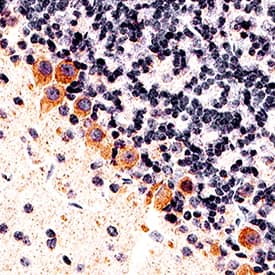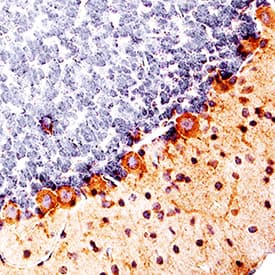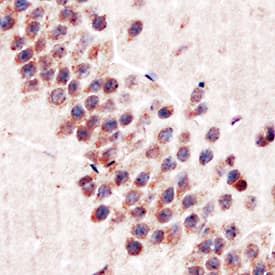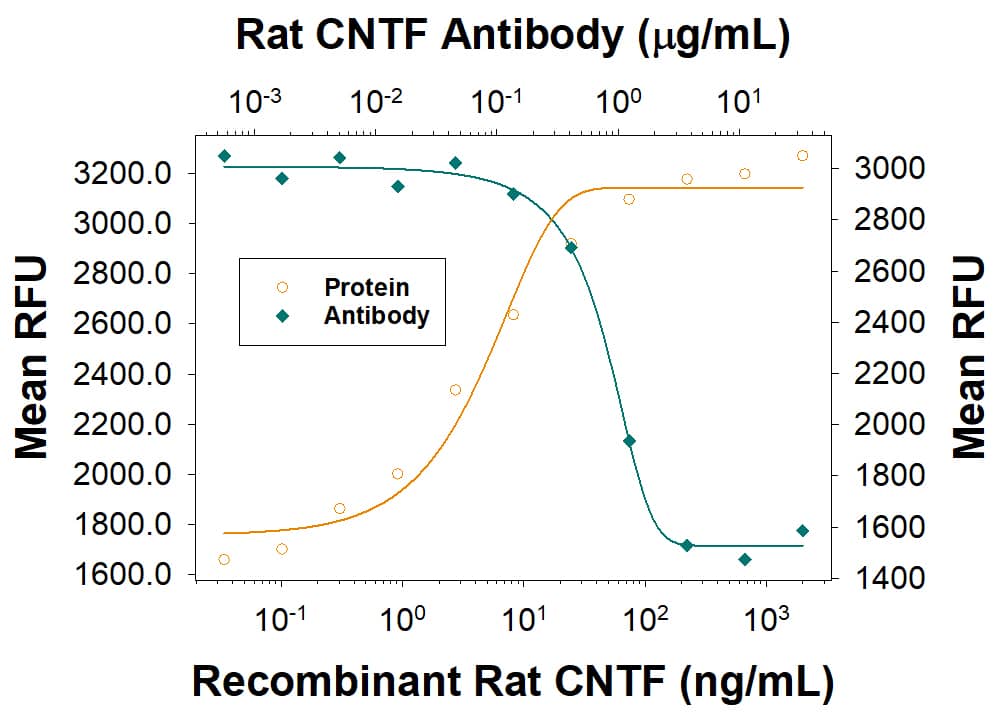Mouse/Rat CNTF Antibody
R&D Systems, part of Bio-Techne | Catalog # AF-557-NA


Key Product Details
Species Reactivity
Validated:
Mouse, Rat
Cited:
Mouse, Rat, Transgenic Mouse
Applications
Validated:
Immunohistochemistry, Neutralization
Cited:
Immunohistochemistry, Western Blot
Label
Unconjugated
Antibody Source
Polyclonal Goat IgG
Product Specifications
Immunogen
E. coli-derived recombinant rat CNTF
Ala2-Met200
Accession # P20294.1
Ala2-Met200
Accession # P20294.1
Specificity
Detects rat CNTF in direct ELISAs and Western blots. Detects mouse and rat CNTF in immunohistochemistry. In direct ELISAs and Western blots, less than 15% cross-reactivity with recombinant human CNTF is observed.
Clonality
Polyclonal
Host
Goat
Isotype
IgG
Endotoxin Level
<0.10 EU per 1 μg of the antibody by the LAL method.
Scientific Data Images for Mouse/Rat CNTF Antibody
CNTF in Mouse Cerebellum.
CNTF was detected in perfusion fixed frozen sections of mouse cerebellum using Goat Anti-Rat CNTF Antigen Affinity-purified Polyclonal Antibody (Catalog # AF-557-NA) at 1.7 µg/mL for 1 hour at room temperature followed by incubation with the Anti-Goat IgG VisUCyte™ HRP Polymer Antibody (Catalog # VC004). Tissue was stained using DAB (brown) and counterstained with hematoxylin (blue). Specific staining was localized to Purkinje neurons. View our protocol for IHC Staining with VisUCyte HRP Polymer Detection Reagents.CNTF in Rat Cerebellum.
CNTF was detected in perfusion fixed frozen sections of rat cerebellum using Goat Anti-Rat CNTF Antigen Affinity-purified Polyclonal Antibody (Catalog # AF-557-NA) at 5 µg/mL for 1 hour at room temperature followed by incubation with the Anti-Goat IgG VisUCyte™ HRP Polymer Antibody (Catalog # VC004). Tissue was stained using DAB (brown) and counterstained with hematoxylin (blue). Specific staining was localized to Purkinje neurons. View our protocol for IHC Staining with VisUCyte HRP Polymer Detection Reagents.CNTF in Mouse Brain.
CNTF was detected in perfusion fixed paraffin-embedded sections of mouse brain (hippocampus) using Goat Anti-Rat CNTF Antigen Affinity-purified Polyclonal Antibody (Catalog # AF-557-NA) at 5 µg/mL for 1 hour at room temperature followed by incubation with the Anti-Goat IgG VisUCyte™ HRP Polymer Antibody (Catalog # VC004). Before incubation with the primary antibody, tissue was subjected to heat-induced epitope retrieval using Antigen Retrieval Reagent-Basic (Catalog # CTS013). Tissue was stained using DAB (brown) and counterstained with hematoxylin (blue). Specific staining was localized to cell membranes and cytoplasm of Purkinje cells. View our protocol for IHC Staining with VisUCyte HRP Polymer Detection Reagents.Applications for Mouse/Rat CNTF Antibody
Application
Recommended Usage
Immunohistochemistry
5-15 µg/mL
Sample: Perfusion fixed frozen sections of rat spinal cord, rat cerebellum and mouse cerebellum, and perfusion fixed paraffin-embedded sections of mouse brain (hippocampus)
Sample: Perfusion fixed frozen sections of rat spinal cord, rat cerebellum and mouse cerebellum, and perfusion fixed paraffin-embedded sections of mouse brain (hippocampus)
Neutralization
Measured by its ability to neutralize CNTF-induced proliferation in the TF‑1 human erythroleukemic cell line. The Neutralization Dose (ND50) is typically 0.3-2.4 µg/mL in the presence of 20 ng/mL Recombinant Rat CNTF.
Formulation, Preparation, and Storage
Purification
Antigen Affinity-purified
Reconstitution
Reconstitute at 0.2 mg/mL in sterile PBS. For liquid material, refer to CoA for concentration.
Formulation
Lyophilized from a 0.2 μm filtered solution in PBS with Trehalose. *Small pack size (SP) is supplied either lyophilized or as a 0.2 µm filtered solution in PBS.
Shipping
Lyophilized product is shipped at ambient temperature. Liquid small pack size (-SP) is shipped with polar packs. Upon receipt, store immediately at the temperature recommended below.
Stability & Storage
Use a manual defrost freezer and avoid repeated freeze-thaw cycles.
- 12 months from date of receipt, -20 to -70 °C as supplied.
- 1 month, 2 to 8 °C under sterile conditions after reconstitution.
- 6 months, -20 to -70 °C under sterile conditions after reconstitution.
Background: CNTF
Long Name
Ciliary Neurotrophic Factor
Alternate Names
ciliary neurotrophic factor, HCNTF
Gene Symbol
CNTF
UniProt
Additional CNTF Products
Product Documents for Mouse/Rat CNTF Antibody
Product Specific Notices for Mouse/Rat CNTF Antibody
For research use only
